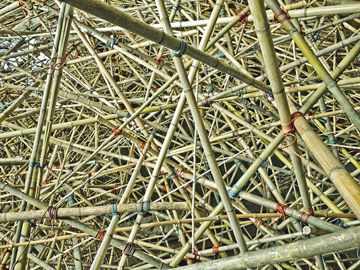Each year the graduates and upperclassmen I work with look forward to their final project as a way of leaving a stamp on the school itself. Students are asked to create an installation on their own, or with a partner, and display it somewhere inside or outside the school building. I only ask that it be placed (or performed) in a spot that doesn’t usually feature art. Students learn in this final unit that artists sometimes use rooms or unexpected places as their canvas and often make works that are specific for a site- such as a stairwell or an underutilized office. They also learn that installations, being works of art designed for three-dimensional spaces, sometimes involve the viewer IN the work, such as Doug and Mike Starn’s “Big Bambú” exhibited on the roof of the Metropolitan Museum last year. Occasionally, as was the case with this piece, viewers are even able to walk into the work itself.
But teaching about installation is much more than showing a collection of great images by artists such as Bruce Nauman, Kiki Smith, Hans Haacke, Judy Pfaff, Pepon Osorio and Sarah Sze, for example, and asking students to have a go at it. Great installations, like lots of great art, require a ton of good planning. So while I may start students off with showing a variety of approaches to installation, I also want to make sure that their initial sketches are working with themes that are meaningful to them and include materials that are accessible in one way or another. There’s nothing more frustrating than having a great idea and then finding out the cost or scale of the project will bring everything to a grinding halt. This initial planning often makes or breaks these student installations. I know because I’ve seen both ends of the installation success stick… I’ve had students abandon great projects because ideas were just too big and had others generate tremendous excitement through straightforward, unique works.
Taking the first stages of installation slowly and really getting involved in the planning with students, as well as those that will help create the art, is crucial. As we proceed into this coming week, I have some students creating installations involving performance, some enabling viewers to “re-see” things they take for granted (like each other), and some using everyday objects as design elements for larger-scale works. Students have begun gathering materials and assembling the works. They have secured spots for their work and have enlisted the help of others to assist in realizing their ideas. As we get closer and closer to the end of the school year, I realize that in units such as this I can probably be most helpful at the start. But I also need to be mindful about getting out of the way once all the “front-end work” is complete.
More to come!
